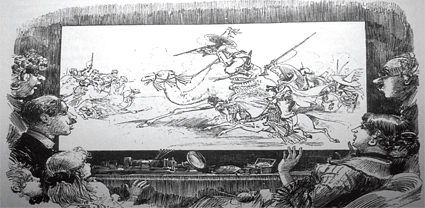Techno-Vision Deluxe
RANCHO MIRAGE, CALIF.—New minefields have turned this year's Hollywood Post Alliance (HPA) Tech Retreat into a full week extravaganza.
Preceding the main event (Feb. 16-18) at the Rancho Las Palmas resort are two days of separately priced seminars on reference monitoring, next generation broadcasting, and workflow.

Among the items HPA Host Mark Schubin will cover in his "post retreat treat" is this 19th century illustration of the Telephonoscope, a concept that married moving images with the telephone. Discussion of reference monitoring is particularly timely, given the lack of traditional monitors of choice (Sony CRTs) and new technologies on the market, according to Paul Chapman, senior vice president of technology for Burbank-based post house FotoKem and host of the Tech Retreat's Reference Monitoring panel, Thursday, Feb 17.
"Everybody's struggling to understand the new technology and how we deal with it," he said. Manufacturers and key users will discuss the calibration and lighting environment for the new monitors, plus high dynamic range. "I would like [the audience] to come away with a better understanding of the different technologies—and the price/performance issues."
Well-known industry veteran Charles Poynton will host a Reference Picture Monitoring seminar on Monday, Feb. 14 and recap the topic Thursday, prior to Chapman's Reference Monitoring panel.
On Tuesday, the Advanced Television Systems Committee will reprise the nextgen television symposium held in October. Concurrently, HPA will host a workflow supersession featuring major Hollywood studios.
WEDNESDAY IS DISTRIBUTION DAY
Wednesday's agenda covers "the whole landscape of how people get to watch stuff," said Tech Retreat host Mark Schubin.
Highlights include NetApp's Senior Product Marketing Manager Ingo Fuchs on leveraging cloud storage technologies to create "Global Content Repositories for Distributed Workflows"; and Jonathan Jenkyn, development engineer at U.K.-based Screen Subtitling Systems, who will discuss "Subtitling for Stereographic Media."
"The issues with not accounting for 2D cue paradoxes in a stereographic environment range from the subtle [slightly longer accommodation time] to the severe [visual fatigue, migraine stimulation, epileptic seizure]," said Jenkyn, "We are now in the final throes of developing an auto-positioning utility as an extension to our 3DITOR suite for positioning subtitles."
After lunch, Dolby Laboratories' Ken Hunold will offer an antidote to the audio blame game entitled "Pool Feeds & Other Shared Origination: How Will They Sound."
The presentation "suggests what can be done to make the distribution and delivery systems more transparent," said Hunold.
The afternoon will also feature talks on the FCC's required content descriptions, multiformat delivery, and content distribution by nontraditional ("Over-The-Top") technologies. "If people have a fast enough broadband connection, they can stream content and not have to buy a pay TV channel package," said Peter Putman, president of ROAM Consultants, co-moderator of the (OTT) Networked Television Sets panel.

The Rancho Las Palmas resort in Rancho Mirage will host the HPA Tech Retreat, Feb. 16-18.PRODUCTION AND POST
Thursday morning, Michael Guncheon will discuss HD SLRs. Schubin, himself, will recap alternatives to the 2-lens 3D shoot, followed by a talk on single-lens stereoscopy by SoliDDD's Neal Weinstock. Schubin also promised a sneak peak at a hot new camera.
After lunch, panels will discuss apps for managing, storing and distributing content. Disney's Howard Lukk will moderate "Interoperable Mastering/Interoperable Media." Panelist Annie Chang, vice president of engineering, worldwide technical services, for Disney, is expected to provide insight into interoperable mastering; the European Broadcasting Union's Hans Hoffmann and Brad Gilmer, head of the Advanced Media Workflow Association, will tackle formats for broadcast and handheld devices.
Subsequent panels will discuss post production for file-based cameras, cloud computing, and Linear Tape-Open Ultrium storage. The session will close with Disney's tell-all on restoring live action movies, and a showing of Sony's restored "Dr. Strangelove."
On Friday, Peter Symes' SMPTE morning overview will be followed by a talk on high dynamic range by Digital Vision's Alexa Chollet and demos of 3D analysis models by TimeSlice/Digicave.
Drew Lanham, senior vice president of media business for Nexidia, a provider of audio and speech analytics software, will demonstrate technology to automatically assess the audio conformance of distributed content to the master copy. He will then compare this method to the subjective and time-consuming manual procedure used today to find gaps, drift, incorrect language or content (music, SFX, subtitles) and other flaws. "It can take hours to assess one movie manually versus seconds to accurately evaluate audio conformance using Nexidia technology," said Lanham.
Following that, Sean McKee and Victor Panov of IVC/Point.360 will present a single strand alternative to Hollywood's expensive and problematic practice of archiving blockbusters on 3-strands of film [red , green, blue], said Schubin. Belden's Steve Lampen will share insight on cables.
Schubin will close the retreat with a recap of historical antecedents that led to TV and film. To register for the retreat, visit www.hpaonline.com.
Get the TV Tech Newsletter
The professional video industry's #1 source for news, trends and product and tech information. Sign up below.
